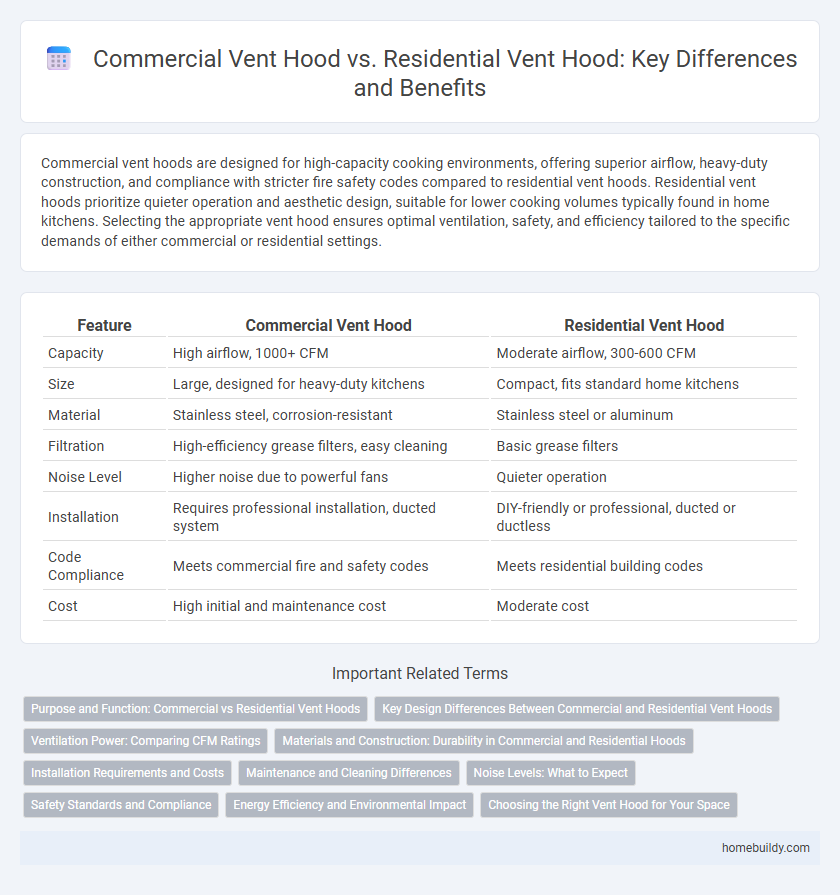Commercial vent hoods are designed for high-capacity cooking environments, offering superior airflow, heavy-duty construction, and compliance with stricter fire safety codes compared to residential vent hoods. Residential vent hoods prioritize quieter operation and aesthetic design, suitable for lower cooking volumes typically found in home kitchens. Selecting the appropriate vent hood ensures optimal ventilation, safety, and efficiency tailored to the specific demands of either commercial or residential settings.
Table of Comparison
| Feature | Commercial Vent Hood | Residential Vent Hood |
|---|---|---|
| Capacity | High airflow, 1000+ CFM | Moderate airflow, 300-600 CFM |
| Size | Large, designed for heavy-duty kitchens | Compact, fits standard home kitchens |
| Material | Stainless steel, corrosion-resistant | Stainless steel or aluminum |
| Filtration | High-efficiency grease filters, easy cleaning | Basic grease filters |
| Noise Level | Higher noise due to powerful fans | Quieter operation |
| Installation | Requires professional installation, ducted system | DIY-friendly or professional, ducted or ductless |
| Code Compliance | Meets commercial fire and safety codes | Meets residential building codes |
| Cost | High initial and maintenance cost | Moderate cost |
Purpose and Function: Commercial vs Residential Vent Hoods
Commercial vent hoods are designed to handle high-volume cooking environments, efficiently removing smoke, grease, and heat generated by industrial-grade appliances, thus ensuring compliance with strict health and safety regulations. Residential vent hoods prioritize quieter operation and aesthetic integration while providing adequate ventilation for lower-intensity cooking tasks typical in home kitchens. The primary function divergence lies in commercial hoods offering robust air filtration and exhaust capacity, whereas residential units balance performance with user comfort and space constraints.
Key Design Differences Between Commercial and Residential Vent Hoods
Commercial vent hoods are engineered with stronger materials such as stainless steel and incorporate high-capacity exhaust fans designed to handle intense heat, grease, and smoke from large-scale cooking operations. Residential vent hoods prioritize quieter operation and aesthetic design, featuring lower airflow rates and integrated lighting suited for home kitchens. The fire safety features in commercial vent hoods are more advanced, including built-in fire suppression systems, while residential hoods typically rely on basic grease filters and less rigorous ventilation standards.
Ventilation Power: Comparing CFM Ratings
Commercial vent hoods typically offer higher ventilation power with CFM ratings ranging from 1,000 to 4,000, designed to handle intense cooking environments and heavy grease extraction. Residential vent hoods generally have lower CFM ratings between 200 and 600, sufficient for typical home kitchens with lighter cooking demands. Choosing the right vent hood depends on kitchen size and cooking volume, ensuring optimal air quality and safety.
Materials and Construction: Durability in Commercial and Residential Hoods
Commercial vent hoods are constructed from heavy-duty stainless steel, designed to withstand rigorous use and high temperatures in commercial kitchens, ensuring long-lasting durability. Residential vent hoods often utilize lighter materials such as aluminum or thinner gauge steel, balancing durability with aesthetic appeal for home use. The robust construction of commercial hoods includes reinforced welds and fire-resistant coatings, while residential models prioritize quieter operation and seamless integration into kitchen design.
Installation Requirements and Costs
Commercial vent hoods require professional installation with compliance to strict fire and ventilation codes, often necessitating grease duct systems and fire suppression units, resulting in higher labor and material costs. Residential vent hoods typically have simpler installation processes with fewer regulatory constraints, allowing for DIY options or lower-cost professional services. The overall expense for commercial systems can be two to three times greater than residential units due to specialized components and certification requirements.
Maintenance and Cleaning Differences
Commercial vent hoods require more frequent and intensive cleaning due to higher grease accumulation and stricter health regulations compared to residential vent hoods. Maintenance for commercial systems involves professional inspections and grease trap cleanings to prevent fire hazards, whereas residential vent hoods typically need simpler, less frequent filter replacements and surface cleanings. The robust design of commercial vent hoods accommodates heavy-duty use and easier access for thorough cleaning processes.
Noise Levels: What to Expect
Commercial vent hoods typically operate with higher noise levels due to powerful motors and heavy-duty fans designed for extensive cooking environments, often exceeding 70 decibels. Residential vent hoods are engineered for quieter operation, usually maintaining noise levels between 40 to 60 decibels to ensure comfort in home kitchens. Understanding these differences helps in selecting a vent hood that balances ventilation needs with acceptable noise levels.
Safety Standards and Compliance
Commercial vent hoods adhere to stricter safety standards and compliance regulations compared to residential vent hoods, including requirements set by the National Fire Protection Association (NFPA) and Underwriters Laboratories (UL). These hoods must efficiently handle higher volumes of grease-laden vapors and incorporate features like fire suppression systems and heavy-duty grease filters to prevent kitchen fires. Residential vent hoods typically follow local building codes with less rigorous standards focused on residential ventilation and noise control.
Energy Efficiency and Environmental Impact
Commercial vent hoods are designed for high-capacity air extraction, often consuming more energy due to powerful motors and larger airflow requirements, whereas residential vent hoods operate at lower capacities, resulting in lower energy consumption. Energy-efficient commercial vent hoods incorporate variable speed fans and advanced filtration systems to reduce electricity usage and minimize environmental impact. Residential vent hoods benefit from ENERGY STAR certification, promoting reduced carbon emissions through optimized motor efficiency and lower noise levels.
Choosing the Right Vent Hood for Your Space
Commercial vent hoods are designed with higher airflow capacities and robust materials to handle heavy cooking demands and meet stringent health codes, making them ideal for restaurants and large kitchens. Residential vent hoods prioritize quieter operation, aesthetic appeal, and compatibility with typical home cooktops, suitable for moderate cooking activities. Selecting the right vent hood depends on kitchen size, cooking frequency, ventilation requirements, and compliance with local regulations to ensure optimal performance and safety.
Commercial vent hood vs Residential vent hood Infographic

 homebuildy.com
homebuildy.com